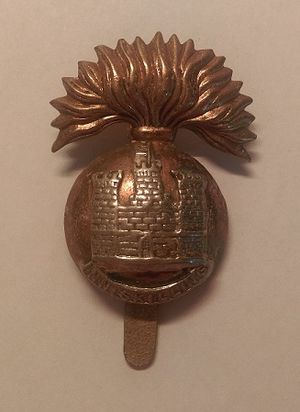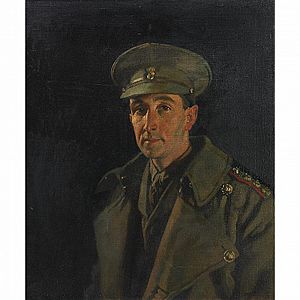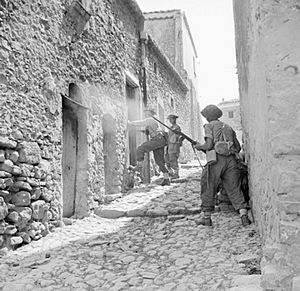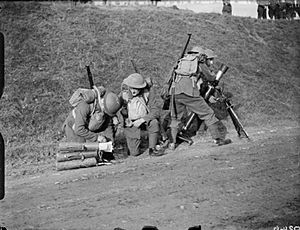Royal Inniskilling Fusiliers facts for kids
Quick facts for kids Royal Inniskilling Fusiliers |
|
|---|---|

Royal Inniskilling Fusiliers Cap Badge
|
|
| Active | 1881–1968 |
| Country | |
| Branch | |
| Type | Infantry |
| Role | Line infantry |
| Size | 1 Regular battalion at amalgamation (10 during the Great War) |
| Garrison/HQ | St Lucia Barracks, Omagh |
| Nickname(s) | The Skins |
| Motto(s) | Nec Aspera Terrant (By difficulties undaunted) (Latin) |
| Colors | Blue facings |
| March | Quick – The Sprig of Shillelagh & Rory O'More Slow – Eileen Alannah |
| Anniversaries | Waterloo Day, 18 June Somme Day, 1 July |
| Engagements | Badajoz, Waterloo, Gallipoli, Burma |
| Commanders | |
| Colonel of the Regiment |
Prince Henry, Duke of Gloucester |
| Insignia | |
| Hackle | Grey |
| Tartan | Saffron (pipes) |
The Royal Inniskilling Fusiliers was a famous Irish infantry regiment in the British Army. It existed from 1881 until 1968. This regiment was created by joining two older regiments: the 27th (Inniskilling) Regiment of Foot and the 108th Regiment of Foot.
The Royal Inniskilling Fusiliers fought in many important conflicts. These included the Second Boer War, the First World War, and the Second World War. In 1968, it joined with other regiments to form the Royal Irish Rangers. These other regiments were the Royal Ulster Rifles and the Royal Irish Fusiliers (Princess Victoria's).
Contents
History of the Royal Inniskilling Fusiliers
Early Years: 1881 to 1914
On July 1, 1881, the 27th and 108th Regiments of Foot became the 1st and 2nd Battalions of the Royal Inniskilling Fusiliers. In 1903, the regiment received a special grey feather, called a hackle. This feather was worn on their hats. It honored the original grey uniforms of the Inniskilling Regiment.
The regiment's home area included Londonderry City and the counties of Donegal, Londonderry, Tyrone, and Fermanagh in Ireland. Their main base was at St Lucia Barracks in Omagh. Local volunteer groups also became part of the new regiment.
- 3rd Battalion: Fermanagh Light Infantry Militia
- 4th Battalion: Londonderry Light Infantry (later changed to artillery)
- 4th Battalion (originally 5th): Royal Tyrone Fusiliers
- 5th Battalion (originally 6th): Prince of Wales's Own Donegal Militia
The British Army had a system where one battalion stayed in the United Kingdom. The other battalion served overseas. They would switch places every few years.
Fighting in the Second Boer War
In October 1899, the Second Boer War began in South Africa. The 1st Battalion arrived in Durban. They joined the 5th (Irish) Brigade. The battalion faced tough battles against the Boers. These battles were part of a difficult period known as "Black Week". This time ended with a defeat at the Battle of Colenso.
The unit then fought in the Tugela Campaign. They helped to rescue Ladysmith in early 1900. The regiment even gave its name to "Inniskilling Hill." The 5th Brigade captured this hill in February 1900. The war ended in June 1902. The 1st Battalion stayed in South Africa until January 1903.
The 2nd Battalion arrived in South Africa later in the war. It saw very little action.
The First World War: 1914 to 1918

During the First World War, the Royal Inniskilling Fusiliers grew much larger. They had many battalions fighting in different places.
Regular Army Battalions
The 1st Battalion returned from India in January 1915. It landed at Cape Helles in Gallipoli in April 1915. After fighting there, it moved to Egypt in January 1916. Then, it went to Marseille in March 1916 to serve on the Western Front.
The 2nd Battalion arrived in Le Havre in August 1914. It served on the Western Front. This battalion was heavily involved in the Battle of Le Cateau in August 1914.
New Battalions for the War
Many new battalions were formed for the war.
- The 5th and 6th Battalions landed at Suvla Bay in Gallipoli in August 1915. They later moved to Salonika for the Macedonian front. In May 1918, they went to France.
- The 7th and 8th Battalions arrived in France in February 1916. They served on the Western Front.
- The 9th, 10th, and 11th Battalions landed in France in October 1915. They also served on the Western Front.
Easter Rising in Dublin
During the Easter Rising in Dublin in 1916, the 12th (Reserve) Battalion fought against Irish rebels. These rebels wanted to end British rule in Ireland. Two Royal Inniskilling Fusiliers were killed, and seven were wounded.
Between the World Wars
After the First World War, the 1st Battalion moved to India. The 2nd Battalion was based in England. In 1922, when the Irish Free State became independent, many Irish regiments were to be disbanded. However, the Inniskillings were one of the few that remained.
The 1st Battalion moved from India to Iraq in 1922. It returned to England in 1925. From 1927 to 1933, it was stationed in Northern Ireland. Then it moved to Aldershot. In 1934, it went overseas again, serving in Shanghai and Singapore.
In 1937, the army expanded. The 2nd Battalion was reformed in Omagh. It moved to Catterick the next year. By 1939, when the Second World War began, the 1st Battalion was in India, and the 2nd Battalion was in England.
The Second World War: 1939 to 1945
The regiment had two regular battalions (1st and 2nd) and raised three more (5th, 6th, and 70th) for the Second World War.
The 1st Battalion was in British India when the war started. It stayed there for the entire war. It fought in the early parts of the Burma campaign. In 1942, the battalion flew to Burma to stop the Japanese advance. In 1943, it fought in the Arakan peninsula.
The 2nd Battalion was part of the BEF in France. It was among the units evacuated from Dunkirk after fierce fighting. The battalion lost many soldiers, with only 215 remaining.
After getting new soldiers and equipment, the 2nd Battalion left England in 1942. They went to Madagascar to fight the French forces there. This was to prevent the Japanese from taking the island. They then served in India, Persia, and Syria. Later, they took part in the invasion of Sicily and then Italy. They fought with the British Eighth Army.
In July 1944, the 2nd Battalion received many soldiers from the 6th Battalion. It joined the 38th (Irish) Infantry Brigade. This brigade was part of the 78th Battleaxe Infantry Division. The battalion fought in battles around the Gothic Line and in the final push in Italy in April 1945.

The 6th Battalion was formed in October 1940. It became part of the 38th (Irish) Infantry Brigade. This brigade was known for its bravery. The 6th Battalion fought in the Tunisian Campaign in North Africa in 1942–1943. It also took part in the landings in Sicily and then Italy.
In February 1943, the 6th Battalion joined the 78th Battleaxe Division. This division was considered one of the best in the British Army. The 6th Battalion fought bravely in Sicily and Italy. A famous battle was at Centuripe in Sicily. Their surprise attack on the town earned great praise. The battalion also fought at the difficult Battle of Monte Cassino. However, it was disbanded in June 1944 due to a shortage of soldiers. Its remaining men joined the 2nd Inniskillings.
After the Wars: Post-1945
After the Second World War, the 1st Battalion returned to India. After a short time in Hong Kong, the regiment fought in the Malayan Emergency. This was against communist fighters. In 1948, both regular battalions joined together to form the 1st Battalion.
In 1949, the battalion went to the West Indies. It returned to the UK in 1951. In 1952, it was given the "Freedom of Enniskillen," its founding town. Later that year, it went to the Suez Canal Zone and then to Kenya. In Kenya, it helped to stop the Mau Mau Uprising. It also received the "Freedom of Nairobi," a rare honor for a British regiment.
The 1st Battalion returned to England in 1955. It then served in Germany, including Berlin. In 1960, part of the battalion was back in Kenya. In 1961, the battalion flew to Kuwait when it was threatened by Iraq. The battalion returned to England in 1962.
In April 1968, the 1st Battalion had its last mission. Part of the battalion went to Bermuda due to political tension. After a peaceful election, they returned to England. On June 30, 1968, the regimental flag was lowered for the last time.
Joining Forces: Amalgamation
On July 1, 1968, the Royal Inniskilling Fusiliers joined with two other regiments. These were the Royal Ulster Rifles and the Royal Irish Fusiliers. Together, they formed the Royal Irish Rangers. This date was chosen because it was the 52nd anniversary of the first day of the Battle of the Somme. Battalions from all three regiments had fought in that battle.
Regimental Museum
The Inniskillings Museum tells the story of the Royal Inniskilling Fusiliers. It also covers the 5th Royal Inniskilling Dragoon Guards. You can find the museum at Enniskillen Castle.
Battle Honours
Battle honours are special awards given to regiments for their bravery in battles.
Honours on the Regimental Colours:
- Martinique 1762
- Havannah
- St Lucia 1778–96
- Maida
- Busaco
- Badajoz
- Salamanca
- Vitoria
- Pyrenees
- Nivelle
- Orthes
- Toulouse
- Peninsula
- Waterloo
- South Africa 1835, 1846–47
- Central India
- Relief of Ladysmith
- South Africa 1899–1902
Honours on the Queen's Colour (10 from each World War):
- Le Cateau
- Somme 1916, '18
- Ypres, 1917, '18
- St Quentin
- Hindenburg Line
- France & Flanders
- Macedonia, 1915–17
- Landing at Helles
- Gallipoli, 1915–16
- Palestine, 1917–18
- North-West Europe 1940
- Djebel Tanngoucha
- North Africa, 1942–43
- Centuripe
- Sicily, 1943
- Garigliano Crossing
- Cassino II
- Italy, 1943–45
- Yenangyaung, 1942
- Burma, 1942–43
Regimental Chapel
The Regimental chapel is located in St Macartin's Cathedral, Enniskillen.
Victoria Cross Heroes
The Victoria Cross (VC) is the highest award for bravery in the British military. Here are some soldiers from the Royal Inniskilling Fusiliers who received this honour:
- Captain Gerald Robert O'Sullivan: For actions on July 1-2, 1915, at Gallipoli.
- Sergeant James Somers: For actions on July 1-2, 1915, at Gallipoli.
- Captain Eric Norman Frankland Bell: For actions on July 1, 1916, at Thiepval.
- Lieutenant Colonel John Sherwood-Kelly: For actions on November 20, 1917, at Marcoing, Cambrai.
- Second Lieutenant James Samuel Emerson: For actions on December 6, 1917, at Hindenburg Line, Cambrai.
- Private James Duffy: For actions on December 27, 1917, at Kereina Peak, Palestine.
- Lance Corporal Ernest Seaman: For actions on September 29, 1918, at Terhand, Belgium.
- Private Norman Harvey: For actions on October 25, 1918, at Ingoyghem, Belgium.
Images for kids






